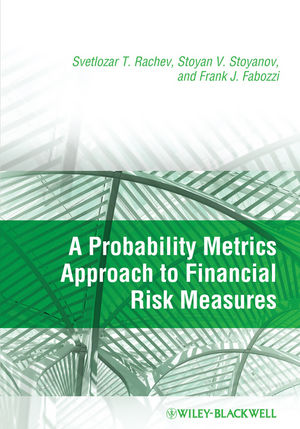A Probability Metrics Approach to Financial Risk MeasuresISBN: 978-1-4051-8369-7
Hardcover
392 pages
February 2011, Wiley-Blackwell
 This is a Print-on-Demand title. It will be printed specifically to fill your order. Please allow an additional 10-15 days delivery time. The book is not returnable.
|
||||||
Preface xiii
About the Authors xv
1 Introduction 1
1.1 Probability Metrics 1
1.2 Applications in Finance 2
2 Probability Distances and Metrics 7
2.1 Introduction 9
2.2 Some Examples of Probability Metrics 9
2.2.1 Engineer’s metric 10
2.2.2 Uniform (or Kolmogorov) metric 10
2.2.3 Lévy metric 11
2.2.4 Kantorovich metric 14
2.2.5 Lp-metrics between distribution functions 15
2.2.6 Ky Fan metrics 16
2.2.7 Lp-metric 17
2.3 Distance and Semidistance Spaces 19
2.4 Definitions of Probability Distances and Metrics 24
2.5 Summary 28
2.6 Technical Appendix 28
2.6.1 Universally measurable separable metric spaces 29
2.6.2 The equivalence of the notions of p. (semi-)distance on P2 and on X 35
3 Choice under Uncertainty 40
3.1 Introduction 41
3.2 Expected Utility Theory 44
3.2.1 St Petersburg Paradox 44
3.2.2 The von Neumann–Morgenstern expected utility theory 46
3.2.3 Types of utility functions 48
3.3 Stochastic Dominance 51
3.3.1 First-order stochastic dominance 52
3.3.2 Second-order stochastic dominance 53
3.3.3 Rothschild–Stiglitz stochastic dominance 55
3.3.4 Third-order stochastic dominance 56
3.3.5 Efficient sets and the portfolio choice problem 58
3.3.6 Return versus payoff 59
3.4 Probability Metrics and Stochastic Dominance 63
3.5 Cumulative Prospect Theory 66
3.6 Summary 70
3.7 Technical Appendix 70
3.7.1 The axioms of choice 71
3.7.2 Stochastic dominance relations of order n 72
3.7.3 Return versus payoff and stochastic dominance 74
3.7.4 Other stochastic dominance relations 76
4 A Classification of Probability Distances 83
4.1 Introduction 86
4.2 Primary Distances and Primary Metrics 86
4.3 Simple Distances and Metrics 90
4.4 Compound Distances and Moment Functions 99
4.5 Ideal Probability Metrics 105
4.5.1 Interpretation and examples of ideal probability metrics 107
4.5.2 Conditions for boundedness of ideal probability metrics 112
4.6 Summary 114
4.7 Technical Appendix 114
4.7.1 Examples of primary distances 114
4.7.2 Examples of simple distances 118
4.7.3 Examples of compound distances 131
4.7.4 Examples of moment functions 135
5 Risk and Uncertainty 146
5.1 Introduction 147
5.2 Measures of Dispersion 150
5.2.1 Standard deviation 151
5.2.2 Mean absolute deviation 153
5.2.3 Semi-standard deviation 154
5.2.4 Axiomatic description 155
5.2.5 Deviation measures 156
5.3 Probability Metrics and Dispersion Measures 158
5.4 Measures of Risk 159
5.4.1 Value-at-risk 160
5.4.2 Computing portfolio VaR in practice 165
5.4.3 Back-testing of VaR 172
5.4.4 Coherent risk measures 175
5.5 Risk Measures and Dispersion Measures 179
5.6 Risk Measures and Stochastic Orders 181
5.7 Summary 182
5.8 Technical Appendix 183
5.8.1 Convex risk measures 183
5.8.2 Probability metrics and deviation measures 184
5.8.3 Deviation measures and probability quasi-metrics 187
6 Average Value-at-Risk 191
6.1 Introduction 192
6.2 Average Value-at-Risk 193
6.2.1 AVaR for stable distributions 200
6.3 AVaR Estimation from a Sample 204
6.4 Computing Portfolio AVaR in Practice 207
6.4.1 The multivariate normal assumption 207
6.4.2 The historical method 208
6.4.3 The hybrid method 208
6.4.4 The Monte Carlo method 209
6.4.5 Kernel methods 211
6.5 Back-testing of AVaR 218
6.6 Spectral Risk Measures 220
6.7 Risk Measures and Probability Metrics 223
6.8 Risk Measures Based on Distortion Functionals 226
6.9 Summary 227
6.10 Technical Appendix 228
6.10.1 Characteristics of conditional loss distributions 228
6.10.2 Higher-order AVaR 232
6.10.3 The minimization formula for AVaR 234
6.10.4 ETL vs AVaR 237
6.10.5 Kernel-based estimation of AVaR 242
6.10.6 Remarks on spectral risk measures 245
7 Computing AVaR through Monte Carlo 252
7.1 Introduction 253
7.2 An Illustration of Monte Carlo Variability 256
7.3 Asymptotic Distribution, Classical Conditions 259
7.4 Rate of Convergence to the Normal Distribution 262
7.4.1 The effect of tail thickness 263
7.4.2 The effect of tail truncation 268
7.4.3 Infinite variance distributions 271
7.5 Asymptotic Distribution, Heavy-tailed Returns 277
7.6 Rate of Convergence, Heavy-tailed Returns 283
7.6.1 Stable Paretian distributions 283
7.6.2 Student’s t distribution 286
7.7 On the Choice of a Distributional Model 290
7.7.1 Tail behavior and return frequency 290
7.7.2 Practical implications 295
7.8 Summary 297
7.9 Technical Appendix 298
7.9.1 Proof of the stable limit result 298
8 Stochastic Dominance Revisited 304
8.1 Introduction 306
8.2 Metrization of Preference Relations 308
8.3 The Hausdorff Metric Structure 310
8.4 Examples 314
8.4.1 The L´evy quasi-semidistance and first-order stochastic dominance 315
8.4.2 Higher-order stochastic dominance 317
8.4.3 The H-quasi-semidistance 320
8.4.4 AVaR generated stochastic orders 322
8.4.5 Compound quasi-semidistances 324
8.5 Utility-type Representations 325
8.6 Almost Stochastic Orders and Degree of Violation 328
8.7 Summary 330
8.8 Technical Appendix 332
8.8.1 Preference relations and topology 332
8.8.2 Quasi-semidistances and preference relations 334
8.8.3 Construction of quasi-semidistances on classes of investors 335
8.8.4 Investors with balanced views 338
8.8.5 Structural classification of probability distances 339
Index 357



